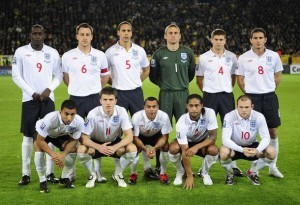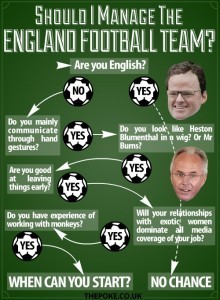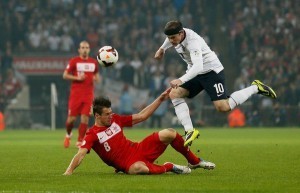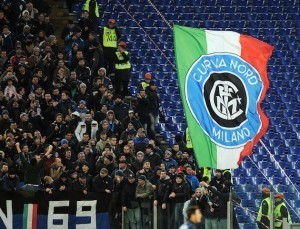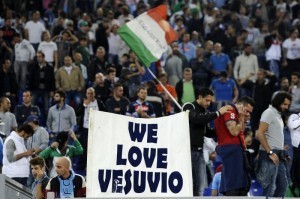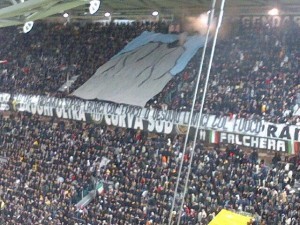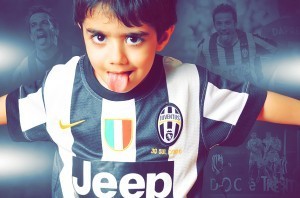Laurent Dubois's Blog, page 88
December 1, 2013
The Danish Fairy Tale
A friend of mine is a fan of F.C. København, the most successful Danish league side of the last 10 years. København have won 7 of the last 10 Danish Superliga titles, but are more famous for being a Cinderella team that beat Manchester United and drew Barcelona and Manchester City in the Champions League. Remarkably, however, København is not the most successful Cinderella that Denmark has produced. That honor belongs to the Danish team that won Euro 1992 against all odds, which wrote a fairy tale that can rival any work by Hans Christian Andersen

The Champions
The Team that shouldn’t have even been there
European football in th 1970s and 1980s was dominated by the Germans and Dutch. These bitter rivals had won 3 of the 5 Euros held in that timespan, and were favored to repeat then dominance in the 1992 Euros. But qualification had to occur first. Sweden, as host country qualified automatically, while the Netherlands, Germany, France, England and Scotland qualified by winning their groups. The Soviet Union qualified, then ceased to exist as a country, but sent a team under the name “Commonwealth of Independent States.” The last team to qualify was Yugoslavia, who had beat out Denmark, Northern Ireland, the Faroe Islands, and Austria for a spot at Euro 1992.
But as so often occurs in football, fate had other plans. After the death of Marshal Tito, ethnic tensions had risen in the Soviet Federal Republic of Yugoslavia. The various ethic groups started arming themselves, creating a very volatile situation. In mid 1992, Slovenia and Croatia declared independence, starting the Yugoslav Civil wars. During these conflicts, atrocities such as the last genocide in Europe occured, resulting in the breakup of Yugoslavia. In an effort to calm the situation, the United Nations passed Security Council Resolution 757, which banned Yugoslav participation in global evens. Part g of the resolution banned Yugoslav participation in sporting events
As a result, the Yugoslav team was disqualified from the 1992 Euros. Denmark, the runners-up in that group, were selected to replace them. Barring the disqualification of the former Yugoslavia, Denmark would not have has a chance to write one of the most remarkable tales in soccer history.
The Danish Team
The Danish team, despite finishing runners up in their group, were actually a solid team. In the 1984 Euros, they had lost to Spain, the eventual runners up, on penalities in the Semifinals. The 1992 team boasted players such Peter Schmeichel, Brian Laudrup, Henrik Andersen, and Flemming Søgaard Povlsen, who all played in the major leagues of Europe. However, the most famous and talented player of that Danish generation, Michael Laudrup, had decided not to go to the tournament due to differences with the coach. Famously, Michael Laudrup though Denmark’s chances were so low that he decided to stay on holiday instead of representing his country

Laudrup must have regretted his decision
The Group Stages
Denmark was placed in a group with France, England, and Sweden (which was another stroke of luck-they may not have qualified from the other group). In the 1st game, they played England, drawing 0-0. In their second game, Denmark faced the host nation, Sweden, but lost 1-0 thanks to a goal by the Parma midfielder Tomas Brolin. At this point, qualification was still possible, but Denmark was last in their group, with only 1 point (France and England had drawn their first two games, so were ahead of Denmark but behind Sweden). At this point, qualification was not in Denmark’s hands; if England won their game by a small margin, Denmark would have been eliminated on goals scored and head to head results.
But Sweden defeated England 2-1 after falling behind early. It was now up to the Danes to determine their own destiny.
In the last game of the Group stages, Denmark faced France, a team brimming with talent. At that point, France boasted players such as Didier Deschamps, Eric Cantona, Laurent Blanc and jean Pierre Papin. During the game, Denmark took an early lead when henrik Larsen scored in the 8th minute. But Papin equalized for France in the 60th minute. As the clock ticked down, Lars Elstrup scored in the 78th minute. With this goal, Denmark was through to the knockout stages.
The Knockout Stages
But what chance did Denmark have? They were drawn against the mighty Dutch team, who were mounting a strong defence of their 1988 championship The Dutch boasted players such as Ruud Gullit, Marco Van Basten, Dennis Bergkamp, Frank De Boer, Frank Riijkard, and Wim Kieft. Gullit, Van Basten, and Riijkard had formed the backbone of the famous Arrigio Saachi A.C Milan teams of the late 1980s, which had won back-to-back European Cups (a feat which has not been equaled since). The Dutch were heavily favored, but football is a game of where any given team can win given the right circumstances.
Those circumstances were provided by Henrik Larsen, who gave Denmark the lead in the 5th minute. The Dutch equalized due to a Dennis Bergkamp goal, but Larsen scored again in the 33rd minute. As the clock was winding down, Denmark seemed destined for a famous victory. But Ruud Gullit scored with 3 minutes to spare, sending the game into overtime. Though both teams threatened, the match went to penalties. It was Peter Schemichel’s time to shine. The newly minted Manchester United keeper has just finished as runners up (to give this a little perspecitive, Sir Alex Ferguson had not yet won his first Premier League). The first Dutch and Danish penalties were scored, but on the second Dutch Penalty, Schmeichel was able to save van Basten’s penalty
The rest of the Danish and Dutch scored, so Denmark won5-4 on Penalties, eliminating the defending champions
The Final
Still, Denmark couldn’t repeat another miracle, could they? After all, they were facing Germany, one of the best teams in the world. The Germans had won the 1990 World Cup, and boasted future legends such as Matthias Sammer, Jürgen Klinsmann, Bodo Illgner, and Andreas Brehme. They had easily beaten Sweden 3-2, with Sweden’s last goal coming in garbage time. Again, the Danes were heavy underdogs.
Surprisingly, the Danes took the lead in the 18th minute- John Jensen, who was later bough by Arsenal solely because of his efforts in the final, scored a screamer with his left foot. It was the first real goal scoring oppurtunity, but the Danes had capitalized. But the German seemed determined to score. For the next 60 minutes, they laid siege to the Danish goal. shot after shot was on targer, with Schmeichel performing acrobatic saves to preserve the Danish lead. It seemed that the Germans would eventually be rewarded for their dominance
But the Danes had destiny on their side. During Euro 1992, one of the most touching stories was that of Kim Vilfort . Vilfort was a Brøndby IF player who was a solid if unspectacular player. Picked to replace Laudrup, he was one of Denmark’s few true offensive threats. However, Vilfort had a 7 year old daughter, Line Vilfort, who was striken with Leukemia. During the tournament, Vilfort had to twice leave the Danish camp because his daughter’s condition was deteriorating. However, he was sent back by his family to rejoin the team, and had scored one of the penalities in the shootout against the Dutch.
In pretty much the second actual chance for the Danes, Vilfort shot a low goal in the 78th minute that evaded Bodo illgner and gave the Danes a comfortable cushion.. They weathered relentless German attempts for another 12 minutes, after which Denmark Were champions of Europe. Sadly, however, Line Vilfort would die soon after the tournament
Denmark’s victory at the 1992 Euros remains the most remarkable moment in the history of that championship. It showed how a team with no superstars could beat teams brimming with individual talent if they possessed defensive discipline, efficient counterattacking, and a healthy dose of luck. The Danes wrote the blueprint which Greece successfully followed in 2004. Yet, the Danish victory remains the most improbable result in the history of the Euros due to the fact that had it not been for Yugoslavia’s disqualification, the team would never have been in the tournament. Yet, Denmark were worthy winners, writing one of the unlikeliest fairy tales in the history of the game.
What’s Wrong with the England Team?
Boasting the likes of Rooney, Lampard, Terry, and others, it is difficult to fathom the lack of success for the English national soccer team. Since defeating West Germany in 1966 4-2, England has failed to win the Fifa World Cup. England has not reached the semifinal of a major tournament since Euro 1996 and in Euro 2012 they were defeated by Italy in the quarterfinals. Current coach of the England squad and former Manchester United great, Gary Neville, expressed his guarded optimism for the English team at the 2014 World Cup in Brazil. He stated, “I don’t think anybody in the England set-up – fans, coaches, players or management – are saying we are going to go to Brazil and win it. When we qualified for the World Cup in 1998 in Rome by getting a draw, everyone thought it was the greatest result of all time (1).”
Neville asserts that the English squad will always face unrealistic expectations by home fans, despite the fact that they have never won a World Cup in South America or in the United Kingdom. Paul Scholes supported Neville’s comments stating that England lacks in quality wins against established squads. Scholes says, “I always get the impression that, whenever England come up against a big nation like those, it is usually a signal that we are going to go out. They’re OK against the Polands and Ukraines — England will beat them all day long — but as soon as a top team comes along? Well…” Scholes goes on to lament the lack of quality players compared to Argentina and Spain.
Interestingly, some of the top talent described by Scholes and Neville perfect their craft in the English Premier League (EPL). They forget that the great Carlos Tevez and Javier Mascherano began their career at lowly West Ham United before joining more established clubs. Thus, although the EPL has come under fire recently for the lack of quality homegrown talent, the league is still widely regarded as the most challenging league in the world compared to Serie A or La Liga due to the physical nature of the English game. In spite of the production of great foreign players, why has this current crop of English players not lived up to their billing in tournaments?
One primary reason for this ineptitude by England could be attributed to the lack of an identity for the national team. Although England does have superstars, who will be the leaders on the pitch and within the locker room? Manchester United defender Rio Ferdinand argued “People talk about the identity of the English national team, well I’d like to know what it is. If you say ‘we’ve got an identity’, then what is it? Break it down, tell me what it is. If I said to you ‘what’s Germany’s identity as a national team? Resilience? Discipline? They’ve still got a bit of that, along with the new stuff – movement, retention of the ball, and so on. I just don’t know what ours is. I’m not even just talking about our first team. I’m talking about their under-21s, under-19s, under-18s and so on. If you look at any of their [Germany’s] teams, you would say they play the same way. Not just Germany, but Spain too. In ours, I don’t really see that (2).”
To try to solve the issues in the English squad, Ferdinand is involved in the Football Association Commission to try to revitalize the image of the national team. By implementing changes at a grassroots level, he believes England can once again compete at the highest level with other European powerhouses. With some of the game’s top youth academies, England has the potential to mold together a great squad. It may not be successful at this World Cup, but it remains to be seen what the national team’s identity will become in the near future.
What are your thoughts on what’s wrong with the England team?
If interested, there’s another great article in the New York Times discussing these issues.
1- http://espnfc.com/news/story/_/id/163...
Territorial Discrimination in Italy
Remember that mom who always went back on her word? The one whose kid would fail his classes, get suspended from school, and then be allowed to go out the next weekend after you thought he’d never see the light of day again. The mom who threatened to ground her kid for the next two months but always caved and never held firm. Well that mom is exactly like the Italian Football Federation (FIGC), an organization whose menacing threats are undermined by a severe lack of enforcement. Specifically, as territorial discrimination by fans in Serie A continues to escalate, the FIGC’s lackadaisical approach hinders the hope of any indelible progress being made.
Despite the increased media attention it has gained over the past year, the issue of territorial discrimination in Italy is by no means a recent problem. Rather, it was simply overshadowed by the racism and fan violence characteristic of Italian football fans. Yet while this issue was placed on the backburner in regard to enforcement, the prevalence of this discrimination is almost immediately evident when one visits the Northern and Southern areas of the country. Stemming from the time when Italy used to be made up of city-states, the North has always generally been more affluent and thriving, while the poorer South of Italy was often hindered by organized crime, such as the Costa Nostra in Sicily or the ‘Ndrangheta in Calabria. Consequently, Northerners have expressed contempt for Southerners in so far as the reputation the country has gained, and this has manifested itself in racist chants between fans of Northern and Southern football teams. In fact, Umberto Bossi formed the Lega Nord federalist and regionalist political party in 1991, which has actually advocated secession of the North to form a country called Padania. And while the North’s resentment of the South is often publicly demonstrated, many of the Southern people are actually loyal supporters of Northern teams. Football teams from Northern Italy, including AC Milan, Inter Milan, and Juventus have been the most historically successful teams in Italy and throughout Europe, yet this Southern support does not merely stem from these teams’ reputations. In 1899, Giovanni Agnelli formed the company FIAT which gave many jobs to poor Southern Italians. In addition to controlling FIAT, numerous members of the Angelli family have served as president of the successful Juventus football club. In fact, Andrea Agnelli, great grandson of Giovanni, is the current president of Juventus. Thus, these FIAT jobs facilitated a mass immigration of Southerners to the more prosperous North while at the same time creating thousands of new Juventus FC fans. Yet even this increased support has not assuaged Northerners, especially when it comes to football matches. And there still exists an animosity of Northern teams by Southern clubs; for example, one of the famous chants at the Napoli matches is “Che non salta Juventino è! (Whoever doesn’t jump is a Juve fan)” – Juan Zuñiga, Napoli winger and member of the Colombian national team, actually jumped during the chant while on the pitch!
The most marked cases of territorial discrimination, however, have been directed at fans of the Napoli football team. AC Milan was punished with a partial stadium ban for shouting anti-Neopolitan chants that “express[ed] discrimination based on territorial origin” during a home game against Napoli on September 22, yet since then, the FIGC has begun to impose more flexible sanctions on territorial discrimination. Discipline is now decreed proportional to the number of supporters involved in racist or discriminatory chanting instead of issuing full closure of certain sections. Moreover, in a home game against Genoa, Juventus supporters recited discriminatory chants against Napoli (who they weren’t even playing) and were handed a 2 game ban of the Curva Sud. During a 2-0 domination of Genoa, Juve ultras could be heard chanting “Wash them [Napoli] with fire, Vesuvius wash them with fire!” and “What a smell, even the dogs run away when the Neopolitans arrive. Oh victims of cholera and earthquakes, you never wash yourselves.” Despite these offenses, however, the FIGC suspended this ban for an entire year as long as the Juventus faithful did not reoffend other territories. In essence, the FIGC recognized its own weakness in enforcement and handed out an empty threat on the condition that Juventus fans simply pinky-swear to behave.
Similar bluffs have already been handed to Inter Milan, Roma, Torino, and AC Milanwho also chanted about Neopolitans and Italian Southerners while playing a Northern club. The FIGC’s sanctions have been too flexible, and fans have taken advantage of their abominable discriminatory freedoms. In early October, Inter Milan Ultras in the Curva Nord began a campaign to break all the rules simultaneously just to have a weekend where all matches were behind closed doors. Clearly the fans are not taking the rules seriously, but when the governing administration of Serie A does nothing to stop it, the situation will only continue to intensify. Fans are not afraid to challenge something they do not believe in, and currently, collective transgression can overcome the FIGC’s lethargic “rules.”
On November 11, football giants Napoli and Juventus clashed in Juventus stadium for an all-important first meeting. Yet the 3-0 rout of Napoli was hardly the subject of discussion the following day, as Juventus Ultras once again aimed discriminatory chants against Napoli, despite having their 2-game ban lifted for a year. As the game proceeded, Juve fans neglected the FIGC rules more than the Napoli defense neglected the likes of Llorente, Pirlo, and Pogba. A large banner of Mount Vesuvius was displayed with a cut-out through which a smoke bomb portrayed an eruption surrounded by pleas for the volcano to wash Napoli with fire. Napoli fans have been no stranger to these harmful displays, as notable chants such as “It takes a bar of soap to wash a dirty Southerner” have echoed throughout the stadium since the time of Diego Maradona. Yet while watching the game, these chants seemed different. It was as though Juventus fans were actually calling out the FIGC rather than the Partenopei (Napoli supporters). Chants continued almost in a protest of the absurdity of the need for “rules” against territorial discrimination, as it was something that had always existed and could never be truly expunged. By asking Vesuvius to destroy their rivals, Juve Ultras were trying to show that we should “laugh at ourselves,” a plea to which even Southern fans applauded.
Nevertheless, the FIGC was not sharp enough to catch this, and Juventus fans were handed a ban and fined for their discriminatory actions. A statement from Lega Serie A proclaimed “Juventus have been fined 50,000 euros and will have to play one game without any fans in the Curva Sud (south stand) and Curva Nord (north stand) section of the stadium for territorially discriminating chants…The Lega Serie A also revokes the suspended sentence and orders the execution of the ban handed on October 28, 2013 with respect to the game between Juventus and Genoa.” Thus, the Curva Nord and Curva Sud will be closed for the December 1st game against Udinese, and the Curva Sud will be closed for the home game against Sassuolo. However, Juventus fans were not the only ones at fault, as Napoli fans were observed throwing hazardous objects at Juventus supporters. In addition, 74 seats were destroyed, and “Four Juventus supporters were injured as a result of said acts and required medical treatment. Furthermore, a girl was hit in the head by a handle, probably torn off one of the doors in the visitors’ section.”
When asked about the chants during the Juventus match, Napoli president Aurelio De Laurentiis shrugged off the implications, merely suggesting that “To see people insulting another group of people is not disgusting…When I hear that [Mount] Vesuvius should wash us away, then it just makes me laugh. It’s satirical. It’s just a provocation to a city which needs to wake up.” Other Napoli and Juventus management, however, did not take this discrimination as lightly. Angelo Pisani, president of the Italian consumer rights’ group and solicitor to Diego Maradona (who was a former Napoli player) issued the following statement:
“They were unjustifiable and shameful insults, chants, and banners of a discriminatory and racist nature, illegal actions, gratuitous and prejudicial violence toward Neopolitan citizens from parts of the Juventus Stadium; unsporting behavior with an objective responsibility of the Bianconero club…They are going to have to respond adequately in court to the unspeakable gestures and shameful actions of their supporters. For this, the citizens of Naples are demanding compensation for all of the damage to persons, the image, the existence and the good name of Napoli fans, calculating in an equitable way 1000 euros for each Partenopeo offended and hurt by the unspeakable actions of the Bianconero fans.”
Yeah, keep dreaming Angelo.
Juventus coach Antonio Conte proclaimed these chants “self-harming,” and general manager Beppe Marotta said, “I would really like it if fans would chant in favor of their own side rather than offending the opposition…It is something that we have got to try to eliminate together.” Yet even from this statement, the immediacy of the problem of territorial discrimination is not quite conveyed. Rather, it seems that everyone is merely admitting the problem without doing anything about it. Except the FIGC, which finally (FINALLY) followed through with their ban, right? Not quite.
After hearing the ruling of the FIGC, president of the Italian National Olympic Committee, Giovanni Malago, had different ideas. He proposed that the stadium (specifically the Curva Nord and Curva Sud) be filled with children, citing the success of the Turkish sports club Fenerbahçe when they let only women and children into a league game with Manisapor in 2011 after a pitch evasion. In his proposal, Malago sought to ban only those that had actually caused the trouble and claimed that it would “…be like when we confiscated assets from the Mafia.” Perhaps this was another unintentional blight at the Southern Italians, who once again fell short as the penalty for the injustice they incurred was again rescinded upon acceptance of Malago’s plan. In fact, the game time for the Juventus-Udinese match has been moved up from 20:45 to 18:30 (2:45 to 12:30 Eastern time) to better accommodate the children. Tickets were administered free of charge to schools, and children from football schools and academies will occupy Curva Sud, while elementary and secondary school pupils will occupy Curva Nord.
While this is an exciting opportunity and a great way for Juventus FC to make lifelong memories for young fans, I still would not look at this as a victory for the FIGC. Sure, they were able to boot the Ultras for one game, but I can hardly imagine that the fans are that angry at giving up their seats to children for a game against a team who is not competing for the Scudetto. In fact, I would say this is a victory for the fans and for the persistence of territorial discrimination, as once again, the ruling of the FIGC has been undermined. If the FIGC truly wants to take a firm stand against this problem, it needs to start taking itself seriously, which may mean looking for alternative solutions rather than simply banning fans and playing matches in deserted stadiums. Such bans also do harm to innocent, non-violent fans that are punished at the expense of the masses.
Fans are a huge part of soccer games. They are why scoring a goal in an opposing stadium is so difficult and thus counts more than a goal scored at home. And in the case of territorial discrimination in Italy, the fans definitely have the upper hand. After the ruling against the Juventus Ultras, they threatened to go on strike by sitting in silence for the Champions League fixture against FC Copenhagen this past Wednesday (which did not actually happen). Such a statement shows that the fans would rather hurl discriminatory chants toward opposing teams, players, and regions of the country than enjoy themselves at a match.
To overcome this problem, the FIGC needs to be strict and firm in its rules and declarations and perhaps start to impose heavier monetary fines to supporters and their respective clubs. It will be interesting to watch the Juventus match against Udinese on December 1st and to see what impact the children will have. Yet, regardless of this spectacle, stringent disciplinary actions must be taken to ensure that these young children are not being groomed to turn into the radical Ultras the FIGC is trying to fight against.
November 30, 2013
La Fin de l’épreuve de Belounis
La semaine dernière, Zahir Belounis était autorisé de revenir en France, le chapitre ultime d’une saga incroyable. Belounis, footballeur franco-algérien, est déménagé au Qatar en 2010 pour jouer pour l’équipe el Jaish. Quand el Jaish l’a loué à une autre équipe, le premier club a cessé ses paiements de salaire. En réponse, Belounis a intenté un procès à el Jaish, mais il n’a pas réussi à obtenir son salaire. Au contraire, el Jaish a refusé de le payer ; en plus, le club ne lui a pas permis de sortir le Qatar avant que Belounis renonce le procès. Belounis ne pouvait pas sortir le pays sans accord formel du club grâce aux lois kafala, un groupe de lois qataries qui subordonne des travailleurs—même des footballeurs—aux employeurs. Pendant cette épreuve, Belounis ne vivait pas que de la générosité de sa famille en France, la communauté expatriée au Qatar, et des citoyens qataris.
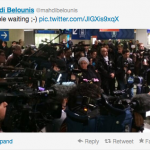
Mahdi Belounis, le frère de Zahir, tweet un photo de la foule qui attend Zahir à Roissy-Charles-de-Gaulle.
Ce qui me frappe le plus de l’histoire de Belounis n’est pas la violation des droits de travailleur, même si la violation est flagrante. L’aspect que je trouve le plus intéressant est le fait que, malgré l’abus, Belounis aime le Qatar, et il admet que le Qatar peut organiser une grande réussite en 2022. Initialement je n’ai pas compris comment une victime de l’oppression peut apprécier le pays où il est opprimé. Cependant, après avoir lu un article de l’affaire Belounis dans le New York Times, j’ai compris qu’il faut faire la distinction entre l’Etat et une poignée de cadres à el Jaish d’un part, et la majorité de citoyens qataris, qui sont innocents d’autre part. Beaucoup de Qataris ont sentaient de compassion, et certains d’entre eux sont allés au-delà de ce qui aurait été attendu, donnant de l’argent à la famille de Belounis pour qu’elle pût survivre. En plus, il ne serait pas logique pour Belounis de n’avoir que de critique de Qatar, car c’est le lieu de naissance de ses filles.
Malheureusement, l’histoire de Belounis n’est pas le seul exemple d’une tragédie résultant du système de travail au Qatar. Tout le monde a commencé de examiner le système de travail au Qatar parce que la FIFA a choisi ce pays comme pays organisateur de la Coupe du monde en 2022. Le journal The Guardian a découvert en septembre que des dizaines de travailleurs népalais eussent mort pendant qu’ils étaient en train de construire une nouvelle ville pour la Coupe du monde. Selon l’auteur de l’article révélateur, le système de travail au Qatar ressemble à celui de l’esclavage. Les exemples de Belounis et des travailleurs népalais sont un grand embarras pour la FIFA et, par conséquent, son choix de la Qatar comme pays organisateur est souvent critiqué dans les médias.
November 28, 2013
World Cup stadium in Brazil collapses
A portion of Itaquero Stadium in Sao Paolo, Brazil collapsed Wednesday when a crane fell on it, killing two workers and leaving a third hospitalized in serious condition. The stadium was meant to be the site of the World Cup’s opening match this summer.
 Although Brazil’s 12 World Cup venues were due to be completed by the end of December, FIFA is yet to announce any plans for a venue change despite the recent collapse.
Although Brazil’s 12 World Cup venues were due to be completed by the end of December, FIFA is yet to announce any plans for a venue change despite the recent collapse.
”It is too premature to make any detailed assessment on the situation of the Corinthians Arena as we are still awaiting the technical report to be able to evaluate the scale of the damage,” FIFA said in a statement sent to the Associated Press. ”We will be able to provide an update earliest next week following the FIFA Organising Committee of the FIFA World Cup.”
Despite the tragic nature of this event, it brings the topics of many Brazilian protests to the forefront of the news. A number of groups have complained about mistreatment of workers at the future World Cup sites, and this incident could be the fuel the movement needs to drum up some attention on the global stage. FIFA, meanwhile, issued a statement Wednesday that said the safety of its workers are of the utmost concerns.
With the current debacle of the 2022 Qatar World Cup continuing to unfold, it’s easy to forget about the turmoil that has gone in Brazil during the past few months. It will be interesting to see the responses by both the host nation and FIFA following this tragedy. It appears an interesting political climate in Brazil could have gotten a little more messy.
November 27, 2013
A tale of two refs
The art of refereeing is a thankless one. No one respects the ref. Players surround him (it’s always men in Men’s soccer) after a call they dont like. Managers abuse him. Fans curse him, burn him in effigy, and generally blame him. Wages are low, benefits are few. And in the view of the majority, their team loses because of the ref, or wins despite him.
While most of that sentiment is down to fanhood, there does exist a spectrum of quality among referees. Most lie in the middle, and most refs in the top European leagues are very good (though they could be better with video replay, though thats a argument for a different time). But there are some who are clearly much better than other, while some are so bad that even the most biased observer would admit they were bad. A example of a great ref is Pierluigi Collina, while one of the more infamous refs of recent times is Byron Moreno.
Byron Moreno
It takes a lot for Sepp Blatter to criticize a ref, as they are the ultimate arbiters of FIFA’s will. But even Blatter had to admit that the refereeing by Moreno has been a “disaster” after the 2002 World Cup Match between Italy and South Korea. While South Korea was a very good team, when they faced Italy, a lot of decisions went in their “favor.”
Watch this video. It’s biased, but does show at least 2 or 3 fouls that should be straight reds. On the other hand, Italy gets whistled for many otherwise innocous fouls
http://www.youtube.com/watch?v=y4lG2RYalS8
Weeks after the end of the world cup, Moreno was suspended by his parent organization, the Ecuadorian FA, due to his actions in a game between Liga Deportiva Universitaria de Quito and Barcelona Sporting Club. Barcelona Sporting was winning the game 3-2 heading into the 90th minute, when Moreno called for an abnormally long 6 minutes of extra time. He let play continue for 13 minutes, during which Liga Deportiva scored the equalizer in the 99th minute and a winner in the 101st minute, after which time was called. Moreno alos falsified the minutes at which Liga scored their equalizing and winning goals in his match report. After serving a 20 game suspension, Moreno “retired” after he was suspended for sending 3 players off in a 1-1 draw. He was obviously suspected of match fixing in both cases
But the story doesnt end there. In 2010, Moreno was arrested at JFK airport in New York for trying to smuggle over 10 pounds of heroin into the US, hidden in his underwear. Arrested and charged with drug smuggling, he was jailed for 26 months before returning to ecuador
Pierluigi Collina
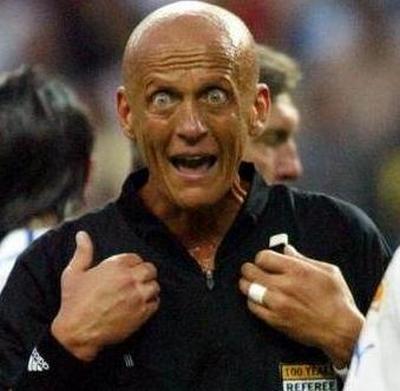
Collina was a scary ref
Few Players get onto the cover of a soccer video game. It is a great hoor, and one must stand alongside Messi, Ronaldo, and Thierry Henry to claim such an honor. But only one ref can claim he was the face of a video game: Pierluigi Collina, who was the face of Pro Evolution Soccer 3 and 4 (along with an appearance as an “unlockable” ref in Fifa 2005.
So great was Collina’s reputation. He was widely regarded as he best ref in Europe for nearly a decade. He reffed the final of the 1999 Champions League Final, the 2004 UEFA Cup Final, and under the brightest spotlight, the 2002 World Cup Final, with no major errors or contentious decisions. Respected by players and fans alike, he has become a cult figure.
Above all, he was regarded as “uncorruptable,” which is even more creditable give the fact that he reffed in Serie A for more than a decade. He earned the hatred of Luciano Moggi, the chairman of Juventus, for apparenty being too “objective.” Moggi was the major culprit behind the Calciocopoli bribery scandal of 2006, which saw Juventus relegated and Italian football shaken
Collina has made quite a career for himself after retiring. He has been seen in advertisements from Japan, to Turkey, to Italy. He was a spokesman for the car manufacturer Opel, and counts many rich and powerful among his admirers.
It goes to show that quality will shine through, even in refereeing
Would you like some Sushi..taka? The Japanese style of soccer
Recently, the Japanese soccer team has been on the rise. They’ve recovered from the recent criticisms arising from their poor performance in the Confederations Cup. In their most recent matches, the Japanese national team has stood toe-to-toe with both the Netherlands and Belgium.
In the match versus the Netherlands, Japan was not fazed at all by the goals of Van der Vaart and Arjen Robben. They played their style of football known as “Sushitaka” and came back from a 0-2 deficit by goals from Yuya Osako and Keisuke Honda. Even though the match ended up on a 2-2 draw, the general consensus was that Japan outplayed the Netherlands. To add on to their hot streak, Japan surprised the world by beating the dark horse of the 2014 Brazil World Cup, Belgium, 3-2 in a friendly match.
The recent success of the Japanese national team can be attributed to the midfielder Yasuhito Endo (Gamba Osaka).
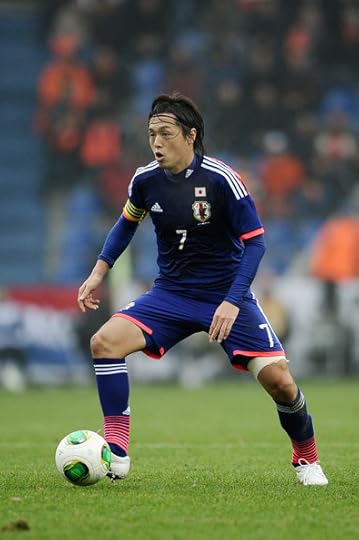
Yasuhito Endo
Endo is a veteran player who has played in 139 matches for Japan since the 2002 World Cup. He has won a spot on the J-league Best Eleven from 2003~2012 and in addition won several other accolades such as 2008 Asian Champions League MVP, and the 2009 AFC Player of the Year. He is known as the Xavi Hernandez of the Japanese football team. However, over the years, Endo’s health has deteriorated to a condition where he can’t play the whole 90 minutes like his old self. Due to this, the so called “Endo Time” was born.
The manager of the Japanese national team, Alberto Zaccheroni, started out by looking for Endo’s replacement. He tried out several players during the East Asian Cup and found his answer in Hotaru Yamaguchi, a 23 year old defensive midfielder. However, Yamaguchi couldn’t perfectly fill up Endo’s shoes. You can’t just replace a player like Endo, similar to how you can’t just replace Zidane, Pirlo, or Xavi. So what Zaccheroni came up with was a plan to use both Yamaguchi and Endo: Yamaguchi during the first 45 and Endo in the last 45.
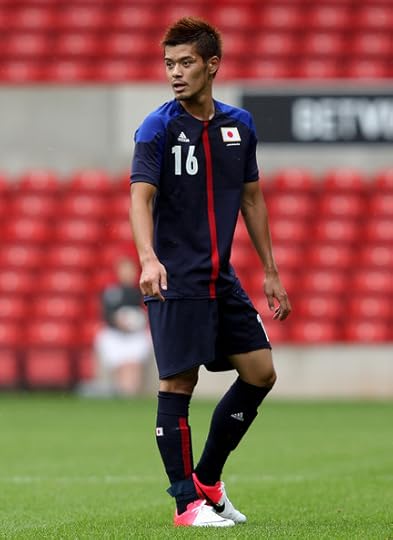
Hotaru Yamaguchi
This plan worked to perfection as Endo came alive when he was put on the pitch. In the match versus Netherlands, when Endo came on the pitch the Japanese were able to score two goals to tie the match at 2. Even Arjen Robben said it felt like a defeat in the second half.
Saving up his energy allowed Endo to play even better than before and as a result, when he came on the pitch during the game against Belgium, he was able to assist a Keisuke Honda goal with a beautiful pass. But it wasn’t as if Endo was the super hero of the match, who saved the Japanese from a terrible defeat. Japan suffocated Belgium in their home ground (the match was held at Baudouin Stadium in Bruxelles). After Mirallas scored the opener on an error committed by Sakai, Japan pulled up their four-back line. Considering the fact that the match was held in Belgium and with opposing players as talented as Hazard and Lukaku, Japan could have easily played a defense-minded game. However, Alberto Zaccheroni decided to meet fire with fire.
After conceding a goal, the Japanese players started to pressure the ball more often as Belgium swung the ball from side to side. As the Belgians retreated back into their side of the pitch, Hazard also had to come down more to receive the ball. From here started the “seal off Hazard” plan. As soon as Hazard got the ball, 2-3 Japanese players stuck to him like glue and forced Hazard from turning and accelerating. This bought time for the Japanese defense to get set before Hazard could turn to counter. This plan held on when Fellaini came on the second half. Also by forcing Mertens and Mirallas out of the danger zone, the Japanese forced the Belgians to pass towards the backs or to the side, something that you don’t really want to do in soccer. Then with players like Hasebe and Endo, Japan was able to shake of the pressure of the Belgian defense. With the creativity of Honda added in Japan was able to score and beat the Belgians in their home ground.
I’d hate to say this but Japan has improved tremendously over the past few years and is considered the “alpha dog” among the Asian countries. Whenever I see Japan and South Korea play, I can really grasp that South Korea is of no match for the Japanese. Also, along with the arise of “Endo Time,” Japan has found the answer to their prayers of a lack of strikers in Yoichiro Kakitani, who scored the wonderful header against Belgium, and Yuya Osako, who scored against Holland. With the help of the new comers and the veterans Hasebe, Honda, and Kagawa, Japan is looking to surprise the world in the 2014 Brazil World Cup.
The Art of Deception…..Also Known as Diving
The soccer “Dive” has become rather infamous in the football world. Many media outlets, critics, and fans alike view the act of diving as a sort of sacrilege to the game. Which is why, for a long time, I held the belief that pretty much everyone in the world hated soccer dives. That was until I stumbled upon the article on Slate titled, ” Why Diving Makes Soccer Great.” (1) Now, it is possible that the author, Austin Kelly, is playing devils advocate; but for the sake of argument I choose to assume that I stumbled upon the sole person in the world that actually enjoys soccer dives.
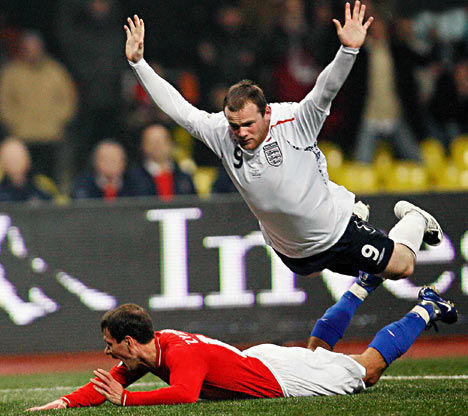
The base line for his argument has been brought up many times before and equates to the notion that diving is a skill. A sort of art form if you will. Specifically Kelly argues that, “Diving is like drawing a charge in basketball. When it is done well, it is a subtle (and precarious) art.” The argument is simply enough but its also bereft of any coherence. A charge in basketball is a fundamental foul call, diving in soccer is an attempt to get a foul call when none such foul was committed. Furthermore, a charge is drawn by a defender when an attacker is charging the goal too aggressively. On the other hand, A dive is done by an offensive player when they are frustrated because they cannot get by an opposing defender.
Clearly, I don’t agree with Kelly, but that’s the thing about opinions, everyone is entitled to them. Sure, good deception is a skill and the perfect dive is an art. In the same way that knowing how to pick a safe is a skill and pulling of the perfect bank robbery is an art but that doesn’t it make it good for the banking industry.
D.B. Cooper or Billy Bob Thorton in Bad Santa?
No matter what side of the fence your on, The diving “epidemic” has become a hot bed of conversation, especially with the upcoming 2014 World Cup. Sure some people argue( but probably only Kelly) that its good for the game, but most critics agree that it has become a problem in professional soccer. It has gained a special notoriety in the media as a laughing point in soccer but (finally) some federations are now attempting to take it more seriously.
http://http://www.youtube.com/watch?v=5TTqQ1ULUPE
Surprisingly, the MLS has become one of the first professional soccer leagues to address the problem head-on. In 2011, the MLS dealt their first fine for an illegal dive. The MLS handed Charlie Davies, a D.C. United Forward, a $1,000 fine for a dive that they believed altered the result of D.C. United’s game against Real Salt Lake (2). Since this first fine in 2011, the MLS has handed out multiple other diving related fines. However, the MLS is one of the only professional soccer organization in the world that is handing out retroactive punishments for illegal dives.
In the birthplace of football, The EPL, seems to have a much more lenient strategy. In a recent interview about Ashley Cole’s blatant dive against Crystal Palace, EPL spokesman Phil Dorward gave a groundbreaking statement; ” If a player is continually booked for diving, and it becomes a problem, we’ll visit the club and talk the player through what is a dive and what isn’t.” (3) Right Phil, because that’s the problem, Ashley Cole simply cant distinguish between what is a dive and what is not a dive. Brilliant.

Granted, perhaps fines are not the cure all to the diving epidemic but at least they are a start. Certainly, the EPL can’t think the catalyst for diving is education or the lack there of. A professional soccer player knows an illegal dive just as well as he knows the offside rule. The players are using the dive because it offers them an opportunity to win, and the only way to counter this is to somehow convince them that diving is not worth it. This could be done via fines, However, we have seen that in the NFL and NBA fines only work to a certain extent.It could also be done via suspensions, but then again suspensions have only stopped a handful of MLB players from taking steroids.
So while the answer to stopping the diving epidemic is unclear, it is clear that the EPL and other prestigious soccer organizations need to start doing something about it. Whatever it may be, fines or suspensions, it is sure to be more effective than an educational sit down.
Citations
(1) http://www.slate.com/articles/sports/...
(2) http://www.mlssoccer.com/news/article...
(3) http://espnfc.com/news/story/_/id/155...
November 26, 2013
November Madness? Why NCAA soccer hasn’t caught on
This weekend, Duke students were treated to an early does of madness, and March is still months away.
Taking the pitch at Koskinen Stadium, the Blue Devil women’s soccer team treated the home fans to back-to-back home wins, including a defensive struggle in an upset of second-seeded Florida and a penalty-kick thriller against Arkansas. With the win, Duke advances to the Elite Eight and a road matchup with top-seeded conference foe Virginia Tech and finds itself peaking at the right time for another deep tournament run.
And although the weekend’s action definitely drubbed up some excitement on campus, it got me thinking why the world’s most popular sport hasn’t really found its niche at the college level. Professional football is one of the largest revenue-generating sports in the world, universities across the United States lose money on its soccer programs each and every year, regardless of whether it’s a winless season or a national championship. Just last week, Michael Reitengen wrote about a number of flaws with the game at the college level—the game is too physical, which is exacerbated by rules that allow for free substitutions. But the real source of the sports struggle at the NCAA level has to do with the culture of soccer itself.
Soccer is a sport that prides itself on professionalism, and professionalism only. Unlike American football or basketball, soccer’s feeder system is not the collegiate system, but rather the academy system, which targets the most talented youth from their teens (and often earlier) and develops them into young soccer machines. Players do not pride themselves on where they went to college, because often times they did not attend college. In Europe, if you are talented enough, you will be signed by a professional team regardless of your age. But the United States and Europe have differing perceptions concerning our education systems.
In America, a college degree is now equivalent to what a high school degree was during our parents’ generation—you aren’t going very far if you don’t have one. Education systems in Europe are often much more career-driven, which can at times make secondary education obsolete—there are fewer stigmas associated with not attending college in Europe than there are in the U.S. Additionally, the MLS has not grown to the point where a professional contract at age 18 outweighs the monetary benefits of even a partial college scholarship for four years plus a degree. After all, 99 percent of the NCAA’s athletes end up going pro in something other than sports.
Because of these fundamental differences, caring about the collegiate game is not engrained in the culture of soccer. Although I have watched a number of incredible athletes take the field for NCAA soccer matches and have been thoroughly entertained by the level of play, it is merely an afterthought in the context of such a monstrous sport.
Even an exciting and high-pressure knockout tournament fails to drum up the attention that basketball players do in March. Another difficulty the NCAA has is soccer’s inherent inability to be monetized from a television perspective. Unlike basketball, there are no commercials every four minutes of gametime. The English Premier League only gets television broadcasts because it is driven by its viewership’s demand, and that is something that collegiate soccer lacks.
Just like any other major collegiate sport, there is triumph and heartbreak, compelling storylines and intense rivalries, but for some reason collegiate soccer just hasn’t caught on.
But I can be sure of one thing. I’d bet that last weekend’s game made a few college soccer fans out of the students in the stands. Even if it was the first college soccer game they’d ever seen, the quality of the matches they saw should give them a reason to come back for more.
November 25, 2013
Soccer Comic Rants with Ian Edwards
To readers who are looking for light-hearted soccer commentary, I want to draw your attention to stand up comedians Ian Edwards and Jason Gillearn’s Soccer Comic Rants on the All Things Comedy podcast network. Edwards and Gillearn’s weekly podcasts provide informed and amusing updates on soccer news around the world, injecting a dose of humor into soccer fans’ dreary Mondays.
I listened to a couple of Ian Edwards’ latest “rants” to get a feel for the show. Soccer Comic Rant #52 from November 18 recapped a week of World Cup playoffs, and Edwards’ asides and zingers enlivened his recap so much that even newcomers to soccer (like yours truly) can enjoy it. Last week, the Brazilian head coach boasted that his team is going to win the World Cup. Edwards’ retort? “You might want to keep your yap shut…You don’t want to act like you’re Kreskin right now. You just want to coach.” (Here, he’s referencing The Amazing Kreskin, who was known for his clairvoyant powers and was a figure on American television in the 1970s.) Here were Edwards’ thought’s on Nigeria’s 2-0 win over Ethiopia: “You’re supposed to beat a country that’s known for not having food. So Nigeria, you did your thing, you’re in the World Cup. Congrats.” Poland’s loss to Slovakia? “Poland, get your sh-t together.”
On this week’s Soccer Comic Rant #53, Edwards hosted a conversation with Monaco player D’Angelo J. Waddington. Born in the Ivory Coast and adopted at 3 years old by a white family, Waddington then moved to Italy, where his adoptive parents put him in the Torino Calcio youth academy. He was only six years old, and was the only black athlete at the academy at the time. “At six years old, you’ve lived a full life… That’s pretty dope,” Edwards exclaimed. Waddington goes on to describe some of the challenges of being a foreign player in an Italian academy in the 1990s—Italy was one of the strongest soccer complexes in Europe, and priority was given to Italian players. The podcasts are entertaining, always informative, and an engaging medium for fans to get soccer news recaps. I’d encourage you to check it out!
Laurent Dubois's Blog
- Laurent Dubois's profile
- 44 followers


